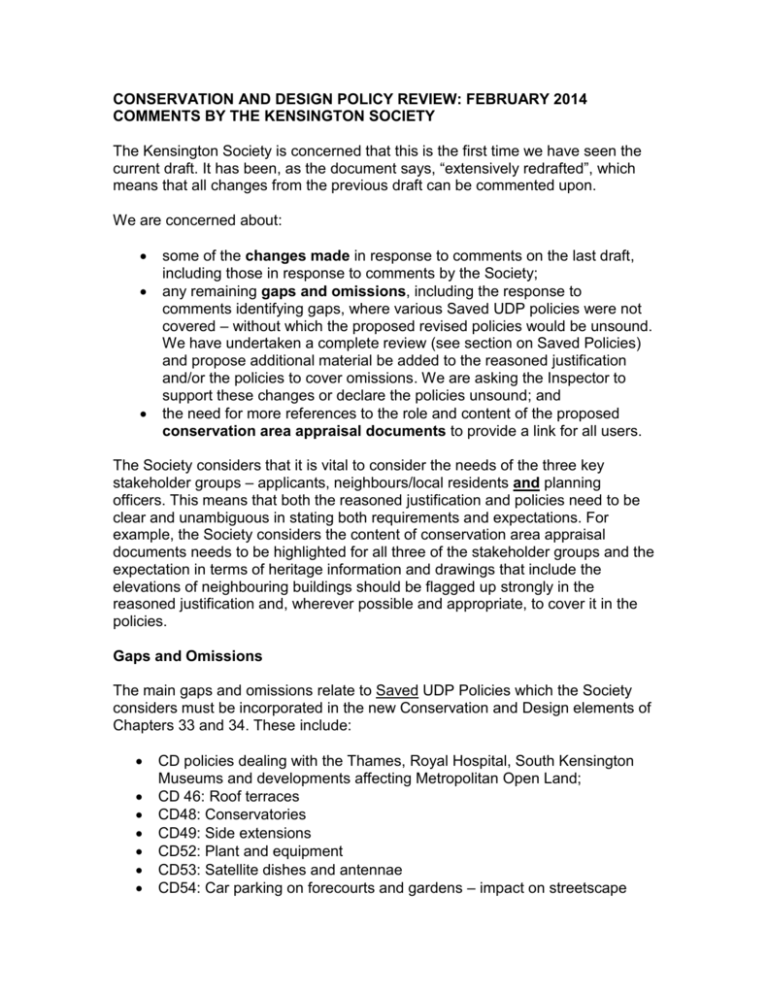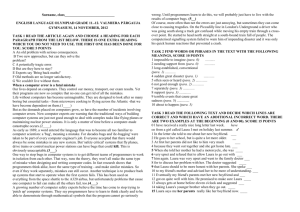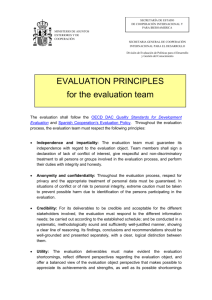Kensington Society comments on Conservation and Design Policy
advertisement

CONSERVATION AND DESIGN POLICY REVIEW: FEBRUARY 2014 COMMENTS BY THE KENSINGTON SOCIETY The Kensington Society is concerned that this is the first time we have seen the current draft. It has been, as the document says, “extensively redrafted”, which means that all changes from the previous draft can be commented upon. We are concerned about: some of the changes made in response to comments on the last draft, including those in response to comments by the Society; any remaining gaps and omissions, including the response to comments identifying gaps, where various Saved UDP policies were not covered – without which the proposed revised policies would be unsound. We have undertaken a complete review (see section on Saved Policies) and propose additional material be added to the reasoned justification and/or the policies to cover omissions. We are asking the Inspector to support these changes or declare the policies unsound; and the need for more references to the role and content of the proposed conservation area appraisal documents to provide a link for all users. The Society considers that it is vital to consider the needs of the three key stakeholder groups – applicants, neighbours/local residents and planning officers. This means that both the reasoned justification and policies need to be clear and unambiguous in stating both requirements and expectations. For example, the Society considers the content of conservation area appraisal documents needs to be highlighted for all three of the stakeholder groups and the expectation in terms of heritage information and drawings that include the elevations of neighbouring buildings should be flagged up strongly in the reasoned justification and, wherever possible and appropriate, to cover it in the policies. Gaps and Omissions The main gaps and omissions relate to Saved UDP Policies which the Society considers must be incorporated in the new Conservation and Design elements of Chapters 33 and 34. These include: CD policies dealing with the Thames, Royal Hospital, South Kensington Museums and developments affecting Metropolitan Open Land; CD 46: Roof terraces CD48: Conservatories CD49: Side extensions CD52: Plant and equipment CD53: Satellite dishes and antennae CD54: Car parking on forecourts and gardens – impact on streetscape CD55: Mews CD79: Hoardings CD81: Planting trees The Council and residents have relied on these saved policies for making decisions and defending appeals. These policies must be included or even improved upon – if not we would consider that the policies have been weakened, which we consider makes them unsound. These are not new policies – they have been vetted and saved and used regularly as grounds for refusal and supported on appeal. Conservation Area Appraisals: The Council has decided to embark on a three-year programme of reviewing the series of Conservation Area Proposals Statements (CAPS) – this must be stated in the revised Conservation section. Part of this review of Conservation and Design was to ensure that any policies in the current CAPS were incorporated in the revised Core Strategy both to ensure consistency but also to be sure that there were appropriate lead policies in the plan. The current CAPS have surveys of roof additions and front boundary treatments with a guide as to the most appropriate changes that would fit with the duty to preserve or enhance the character or appearance of the conservation area. The new text refers the reader to the conservation area appraisals for guidance in interpreting the policy. The Society supports this but considers that there is a need for more references, such as: the end of para 34.3.18; end of para 34.3.43 on Small-scale Alterations and additions end of para 34.3.76, plus a new policy CL8(c) on Roof alterations/additional storeys just as done at the end of 34.3.92 and Policy CL11(c)(i) Detailed Comments: Context and Character: There is a need for all applications that affect the setting of listed buildings and/or the character or appearance of a conservation area need to provide drawings that show the context, such as the elevations of neighbouring properties. This needs to be said clearly somewhere – possible locations include 34.3.4, 34.3.25 and Policy CL3 (d). The 2013 validation requirements do state that where buildings adjoin or are close there should be sufficient elevation information to assess the relationship. Density: Para 34.3.7 fails to recognise that the London Plan Density Matrix sets appropriate density ranges, with the appropriate density for a particular site being based on an analysis of its broad location, accessibility and local context, as well as design. The purpose of the matrix is to indicate the appropriate density range to seek, with densities above and below the density range needing strong justification as exceptions as the London Plan. Without some explanation of the London Plan Policy 3.4 which seeks to “optimise” the density of development of housing sites, Policy CL1 (c) does not mean anything to anybody unfamiliar with the London Plan Policy 3.4, its reasoned justification and the density matrix. The lack of any explanation makes this unsound. We propose the following: “The London Plan Policy 3.4 seeks to optimise the development of housing sites by indicating the appropriate density ranges in the density matrix for particular locations and contexts, setting both upper and lower limits from which developments should only exceptionally depart.” This will provide the justification/explanation for the rather cryptic policy CL1(c). Mews Mews are a special feature of this Borough and the City of Westminster and their special character should be preserved and enhanced. Paragraph 34.3.11 and Policy CL1(h) fails to highlight importance of mews to the Borough’s townscape and to convey the importance of mews to the character of the Borough. Policy CL1(h) needs not only to ensure that their character is preserved and enhanced, but also to replicate UDP Saved Policy CD55 which resists inappropriate alterations and extensions. The Society considers that a stronger policy, as in CD55:“resist inappropriate alterations and extensions to ensure that their special character is preserved and enhanced” Artists’ Studios Para 34.3.12 and Policy CL1(i) needs to include not only the need to prevent the loss of artists’ studios from demolition or physical conversion, but also from change of use. Saved UDP Policy CD56 refers to resisting the loss of artists’ studios. We think the policy needs to unpack this as including both demolition and change of use. There is an SPG on Artist’s Studios whose intention is to maintain the supply of such studios. Policy CL1(i) rewrite as: “To i. resist the demolition of, inappropriate alterations and extensions to and change of use of artists’ studios.” Design Quality Para 34.3.14, lines 4/5: It is not clear what “ease of movement” means. It is unclear whether it is about relative accessibility or access. Para 34.3.15 actually refers to “accessibility”. Policy CL2 does not clarify this other than referring to “inclusive – accessible to all” which is about access. Para 34.3.18: This is where the relationship to adjoining buildings and the role of conservation area appraisal documents should be dealt with. Proposal: Line 2, after first sentence add: “Applications should include drawings that accurately show the design relationship of new development with its neighbours.” Line 4: After “Supplementary Planning Documents” add “, conservation area appraisal documents” Eyesores: Para 34.3.18 and Policy CL2(c): The Society considers this policy unsound as the definition of an eyesore is not objectively defined and promises “a more flexible approach” in order to encourage redevelopment. This approach would put the Council in a weak bargaining position by suggesting that policies would be relaxed. ; Proposal: Delete Para 34.3.18 and Policy CL2(c). CL3: Heritage Assets – Conservation Areas and Historic Places Para 34.3.24: Line 1: Change “the majority” to “about three-quarters” – majority means more than 50% only. Nearly three-quarters of the Borough is covered by conservation areas. Para 34.3.24: First two sentences are policy, but this is not conveyed in Policy CL3. These are sentences must be translated into a policy. If not the policy is not sound. Para 34.3.25: Add at the end: “and drawings must show the relationship to neighbouring buildings.” Or alternatively at the end of para 34.3.27. CL5. Living Conditions The Society considers several aspects of this section unsound, especially the treatment of sunlight and daylight in CL5 (b), which represents a considerable reduction in protection from the current Core strategy policy CL5 (a) and the Saved UDP Policy CD33. Sunlight and Daylight With regard to sunlight and daylight, the existing Core Strategy explicitly recognises that there are large areas of the Borough where, due to the high density of built development and the time when it was built – in the nineteenth century – current light conditions are below the standard we would expect today. Therefore, new development but especially additions and alterations to existing buildings could make these sub-standard conditions materially worse. (Core Strategy paras 34.3.46 and 34.3.47) Saved UDP Policy CD33 says that the Council will “resist development which reduces sunlight and daylight enjoyed by adjoining buildings and amenity spaces” and Saved UDP CD34 says that the Council will “require development to be designed to ensure good light conditions for its buildings and spaces” The 2010 Core Strategy, whilst saving UDP Policies CD33 and CD34, improved on this in Policy CL5(a) currently says that the Council will: “a. require good daylight and sunlight amenity for buildings and amenity spaces, and that the conditions of existing adjoining buildings and amenity spaces are not significantly reduced, or where they are already substandard, that there should be no material worsening of the conditions.” The Society considers that there is a need to protect the standard of daylight and sunlight conditions in existing properties where the conditions of existing adjoining buildings and amenity spaces are already substandard, there should be no material worsening of the conditions (see current CL5(a)) Para 34.3.37: This paragraph and Policy CL5 (b) have lost the issue of where existing sunlight and daylight conditions are already substandard there should be no material worsening. On the other hand the current content of para 34.3.37 is largely meaningless and does not really tackle the issues. It is unclear who makes this judgement and on what basis. The Society considers that both the proposed new reasoned justification (paragraphs 34.3.36 to 34.3.38) and the proposed revised policy CL5 (b) are unsound as they are ineffective as a result of their bland and inoperable nature. Proposal: The current Core Strategy should be retained. The proposed replacement weakens the policy. CL6: Small-scale Alterations and Additions Para 34.3.43: Add at the end: “Careful regard will be had to conservation area appraisal documents”. This is a vital cross-reference to make developers, residents and planners aware of what the conservation area appraisals say. These documents need to identify where existing boundary treatments need to be retained, reinstated or enhanced. This needs to be in the policy CL8: Existing Buildings – Roof Alterations/Additional Storeys At end of Para 34.3.76 the following sentence should be added: “Conservation area appraisal documents will provide local assessments to inform the application of this policy.” Policy CL8: Add new bullet: “c. in determining applications have regard to conservation area proposals appraisals.” CL9: Existing Buildings – Extensions and Modifications Para 34.3.81: Conservatories: This does say clearly that conservatories will be resisted above garden level” - “location in relation to the building and garden” is ambiguous and does not relate to the policy. See wording of Policy CL9 (j) Para 34.3.82: Line 7: Add to the list “balustrades, piers” after “railings” (cf para 34.3.43) to include the range of front boundary treatments to be retained or reinstated. CL10: Shopfronts Para 34.3.83: As justification for the policy of driving up the quality of the area, the reasoned justification needs to support this. At the end of para 34.3.83 add: “All changes to shop fronts should make a positive improvement to the streetscape.” This is essential to make the headline of this policy have meaning for applicants and planning officers. Para 34.3.87: Line 6: Add “and/or viability” – this deals with proposals like 1-3 Thackeray Street, where the building owner was trying to take over the first floor of the shop as a flat and take part of the ground floor to provide access, so undermining the viability of the remaining business. AN ENGAGING PUBLIC REALM Streetscape Para 33.3.16: Line 1: After “conservation areas” add “which cover about 75% of the Borough”. Para 33.3.17: Line 8: After “furniture” add “, retention of historic street furniture” – to provide the reasoned justification to support Policy CR4(c) – it is not set out anywhere else. Para 33.3.19: Line 2: after “parking” add “, including the loss of railings, walls, piers and trees” as these are essential to preserve and enhance the streetscape. Parks, Gardens, Open Spaces and Waterways: Para 33.3.25: Fourth sentence: This gives the wrong impression – it is a strategic issues that the Borough has one of the lowest amount of open space/1000 population in London. CR5 (a) is substantially similar to the existing Core Strategy policy; there is a need for the policy to deal with encroachment into open spaces, especially communal gardens. Policy CR5 (a) change to read: “a. ii. resist the loss of or encroachment into existing:” After “open space” add “, such as garden squares”. SAVED UDP POLICIES The following Saved UDP policies appear to have been omitted or substantially altered as a result of the consolidation process. These policies were refined through several versions of the Borough Plan and the UDP, were specifically saved to provide the much-needed fine-grained policies for dealing with both the sensitivities and extreme development pressures and are frequently used as the basis for planning decisions and are regularly supported on appeal. The Society therefore considers that not to maintain or integrate them into the plan would make the policies they support unsound. Preserving the Character, Views and Vistas in Areas of Metropolitan Importance and Metropolitan Open Land UDP Saved policies CD1- CD16 specifies Areas of Metropolitan Importance and named views which have been expressly included in all previous plans, except the Core Strategy – but only because they were covered by the Saved UDP Policies. These Areas of Metropolitan Importance include: the Thames Policy Area, including the riverside and the Royal Hospital; the South Kensington Museums Area and Metropolitan Open Land. These were sufficiently important to warrant specific sections in the UDP and the policies CD1 to CD16 are important as they relate to: The Thames and the Royal Hospital, both of which are critical to the Thames Policy Area – a London Plan designation – which has not been elaborated as a spatial strategy area in the plan. The Saved UDP policies include CD1, CD2, and CD6 on the Thames and CD8 and CD9 on the Royal Hospital. The South Kensington Museums Area: This is covered by Saved UDP Policies CD10 (views) and CD11 (character): This is another strategic policy area – an Area of Metropolitan Importance. Whilst this is mentioned in the South Kensington chapter 12, specifically in para 12.3.5, it is not included/specifically mentioned in new Policy CL11 on views. Building heights around Metropolitan Open Land – specifically affecting Kensington Gardens and Hyde Park (CD13), Kensington Palace (CD14) and Holland Park (C15). New Policy CL11 does not cover these. The Thames Only CD1 and CD6 are covered by new Policy CL1(d) – whilst they refer to “the riverside”, nowhere in the reasoned justification or new Policy CL1 is the Thames mentioned, despite the fact that it contains iconic views of the bridges, the Chelsea and Battersea riversides. This is a strategic issue and without it the plan is unsound. Royal Hospital: By contrast, the Royal Hospital which is covered by Saved UDP Policy CD8 (views) and CD9 (open spaces) is covered specifically in new Policy CR5 (g) as an open space, but like the Thames is not mentioned under views in new Policy CL11 (see below) Views and Vistas: The section that deals with Views (paras 34.3.90 – 34.3.94) also does not mention the Thames and nor does new Policy CL11. The passing reference in Para 34.3.94 to the Views and Building Heights SPD where “specifically recognised views that are important to protect” are set out. Proposal: All views and vistas for which it was thought worth having a specific policy must be worth identifying in this plan, not relegated to an SPD. All these views and vistas should be listed here. Roof terraces: Saved UDP Policy CD46 is very clear – namely that the Council will: “resist the introduction of roof terraces if: a) b) significant overlooking of, or disturbance to neighbouring properties or gardens would result; or any accompanying alterations or roof alterations are not to a satisfactory design, would be visually intrusive or would harm the street scene.” The Core Strategy only contains one reference to “balconies and terraces” in paragraph 34.3.52 under small-scale alterations and additions, but the issue was covered by the Saved UDP Policy CD46. There is no policy specifically about terraces in CL6 other than generic policies for resisting which harm the character, would cumulatively be detrimental to the character and appearance, not of high quality design. This is replicated in the new Policy CL6. What is missing is specific reference to roof terraces that would cause significant overlooking of or disturbance to neighbouring properties or gardens. New policy CL5 could be said to cover disturbance to neighbours in CL5(e), but new Policy CL5(c) does not explicitly cover overlooking, although new paragraph 34.3.9 does deal with roof terraces and problems of privacy and quiet enjoyment, but does not deal with overlooking – this is not synonymous with privacy which is often just about intervisibility and distances between building frontages. This expressed in new Policy CL5(c) as “reasonable privacy of occupants of new development or in existing properties affected by new development”. Neither is the issue covered by concerns about sense of enclosure. Overlooking is about looking down on people. Avoiding overlooking needs to be part of the assessment criteria for roof terraces. The reasoned justification for the Core Strategy para 34.3.48 refers to “the extent to which [development proposals] involve a significant and unreasonable worsening of overlooking to [adjoining] properties” will be part of the assessment of an application. In short, overlooking was seen as an issue that would be a part of the assessment – even though it did not appear in the policy – they had Saved UDP Policy CD46 to back them up! Since this is frequently an issue both for applications and appeals for terraces and balconies at any level, but particularly at higher levels on the roof of rear extensions and at roof level, the issue need to be covered by this policy. The Society considers that both the Core Strategy and the proposed changes fail to maintain the point in Saved UDP Policy CD46 (a) about overlooking, and therefore the proposed new Policy CL5 is unsound in that it does not deal explicitly with this issue. The Society therefore proposes that proposed reasoned justification and the proposed policy CL5(c) is amended to incorporate the overlooking issue. Specifically, the Society considers that the omission of the overlooking issue makes the policy unsound now that the Council can no longer count on using CD46, and proposes: New para 34.3,39: Line 1 should be amended to read: “Terraces on roofs of main buildings can be visually intrusive and result in serious intrusion into privacy, especially through overlooking, and quiet enjoyment….” Amend new Policy CL5(c) to read: “require that there is reasonable visual privacy for occupants of new development and in existing properties and gardens affected by the development, including avoiding significant overlooking;” Conservatories: Saved UDP Policy CD48 says that the Council will: “Resist proposals for conservatories if: a) b) c) d) located at roof level; located significantly above garden level; covering the whole width of the property; located on a corner site.” The current Core Strategy’s policies for extensions are covered by policies CL2 (d) which require conservatories: i. to be visually subordinate to the original building; and ii. to allow the form of the original building to be clearly seen; and iii. to reinforce the integrity of the original building; and e. to respect those aspects of character and integrity of the original building and group of buildings that contribute to local distinctiveness such as height, width, depth, building line, footprint, position, symmetry, rhythm, materials, detailed design, important gaps and sense of garden openness; Neither of these policies now appear in the new Conservation and Design document. We oppose the loss of Core Strategy policies CL2 (d) and (e). As the Core Strategy only contains an oblique reference to the width of extensions, with the loss of CD48 (c), the new Policy CL9 (j) needs amending. The Society proposes that: Current Core Strategy Policies CL2 (d) and (e) are retained; and new policy CL9 (j) be amended as follows: “j. a conservatory is proposed to be located at roof level, significantly above garden level, cover the whole width of the property or on a corner site.” CD49: Side Extensions CD49: To resist side extensions to buildings if: (a) (b) (c) the architectural symmetry of a building, terrace or group of buildings would be impaired; the original architectural features on a formal flank elevation would be obscured; access to the rear of the property or those adjoining would be lost or reduced.” Side extensions are not specifically cover by the current Core Strategy and the Council, therefore, relies on CD49. The proposed policies do not address this policy and without it the policies are not sound. The Society considers that there is a lack of policy on side extensions, with a lack of clarity about the need to respect gaps in terraces or between pairs of villas. The issue of symmetry and gaps are both mentioned in the existing Core Strategy in Policy CL2(e), which is not included in the new Conservation and Design document. CD52: To resist the installation of plant and equipment where: a) b) they would cause material harm to the appearance of the building or the character of the area; or noise or vibration generated would cause material harm The Core Strategy CL6(b) could be interpreted as covering this if “airconditioning units” are added to the list in new para 34.3.43 in Line 3 after “plant”. Noise and vibration is dealt with in Core Strategy Policy CE6 CD53: To permit satellite dishes and antennas except: a) b) c) on listed buildings where their special character would be harmed; or on the front, side and above the rooflines of buildings where the harm to the character or appearance of the area would be caused; or in other parts of the Borough where they would cause material harm to the appearance of the surrounding area. This policy is essential for taking enforcement action for the removal of a proliferation of satellite dishes. There is no mention of satellite dishes in the Core Strategy, although it could be covered by CL6(b), which says that Council will: “b. require telecommunication, plant, micro-generation and other mechanical equipment to be sited discretely so that visual amenity is not impaired.” The Society considers that for the Local Plan to remain sound the new chapter needs some amendments, namely: Para 34.3.43: Line 4: after “equipment;” add “satellite dishes and antennae;” but also “awnings;” Policy CL6: it needs to be clear that this policy applies to the whole list of items in para 34.3.43. The Society proposes the reinstatement on Core Strategy Policy CL6(b) – see above. CD54: To resist off-street car parking in forecourts and gardens if: a) b) c) d) the proposal would result in the loss of a material part of the existing garden space; the proposal would result in the loss of any trees of amenity value (including street trees); the proposal would result in the demolition of most of the street garden wall or railing, or lead to an unsightly breach of it, particularly where the wall or railings form part of a uniform means of enclosure to a terrace and an essential feature of the street architecture; the car, when parked on the hardstanding, would obstruct daylight or obstruct daylight or outlook enjoyed by the basement dwelling.” In the Core Strategy only part of this has been taken up, scattered between different sections to the point that there is no clear policy as in CD54, namely: Loss of garden space Loss of trees Loss of garden walls and railings: Paras 34.3.22 (Modifications) and 34.3.52 (Small-scale Alterations and Additions) mention walls, railings, etc but there is no clear policy. In response to the Society’s previous representations, the new Conservation and Design paper includes a reference to “railings, piers, gates and forecourt parking” in para 34.3.43, but there is still no policy. Front gardens are also dealt with in revised parts of Public Realm Chapter, para 33.3.19, which should to be extended to cover loss of railings, walls, piers and trees which contribute to the attractiveness of much of our streetscape. Most of the Conservation Area Proposals Statements have identified the nature of front garden boundary treatments that need to be preserved and whenever possible reinstated. However, there is no clear policy statement in the revised Public Realm chapter, except CR4(g) to resist pavement crossovers and forecourt parking – this needs spelling out by extending this policy as these matters are integral to our concerns about our streetscape and public realm. Proposal: In Para 33.3.18, Line 2: After “parking” add “including the loss of railings, walls piers and trees” and add a new policy after CR4(g): resist the loss of traditional railings, walls, piers and trees, and encourage their reinstatement when the opportunity arises.” Without this policy the previous mentions and the work done in conservation area appraisals will be totally ineffective, making the policy unsound. This policy will provide the backing for preserving and enhancing our streetscape. CD55: To ensure that the character of mews properties is preserved and enhanced and to resist inappropriate alterations and extensions The Core Strategy has policies for: protecting small offices in primarily commercial mews (CF5(a) and CH3(a)(i)) protect the character of cobbled mews (para 33.3.9) protect their unique character (para 34.3.16) The Core Strategy does not appear to recognise the need for strong policies to preserve and enhance these areas as in CD55. The revised Conservation and Design policies only refer to mews in Para 34.3.11 and in passing in the revised Policy CL1(h). This says: “h. ensure in carrying out alterations and extensions, the characteristics of the type of building, such as mews, terrace or mansion block, is preserved and enhanced.” The Society considers that as one of the few references to this unique but endangered building type to be unsound. By contrast, Westminster City Council has issued a Supplementary Planning Guidance for Mews. The generic policy CL1(h) above insufficiently specific and does not seek to resist inappropriate alterations and extensions. Proposal: Saved UDP Policy CD55 should be used to provide a new purposebuilt policy for mews which resists inappropriate alterations and extensions. CD77: To permit awnings or blinds which are in character with the age and style of the building in which they are situated This reasoning for this policy was to control poorly designed and over-prominent awnings which can detract from the appearance of buildings and be obtrusive features in the street scene (para 4.6.14) The Core Strategy policy CL2(o) (iii) relates only to shopfronts and “requires new, and alterations to existing shopfronts, to respect the character of the building in relation to siting and design of awnings and blinds”. This policy is repeated in the new CL10(b)(iii). Whereas Saved UDP Policy CD77 applies to all buildings, the Core Strategy relates only to shops. A more general policy such as CD77 is needed for other types of buildings. CD79: To resist the erection of permanent hoardings The reasoning for this policy says that “advertisement hoardings, either freestanding or attached to buildings, are generally considered to be unacceptable as permanent features of the street scene as they detract from townscape quality” (para 4.6.19). Current Core Strategy 33.3.18 Advertising hoardings and freestanding adverts can have a negative impact on visual amenity and can also have serious implications for public and road safety. Policy CR4(f): resist temporary or permanent advertising hoardings, or freestanding adverts on streets, forecourts or roadsides, or advertisements attached to street furniture, where these negatively impact on our high quality townscape or on public or road safety; The revised version the Public Realm section – para 33.3.18 repeats verbatim para 33.3.18 of the Core Strategy, but the Revised Policy CR4(e) and (f) do not provide any policy for hoardings. The focus now is on adverts generally CR4(e) and on free-standing structures, with the example of advert/phones proposed by JCDecaux and BT. As a result both the simple thrust of CD79 and the new challenge of advertisement towers are omitted. Proposal: New Policy CR4(f) needs to be extended to deal with hoardings and advertisement towers. f. resist freestanding structures, such as temporary and permanent advertisement hoardings, advertising towers and telephone kiosks where the function for the display of adverts over-dominates the primary purpose for the structure, whether sited on streets, forecourts or roadsides. Advertisements on street furniture will be resisted. This reinstates CD79 and Core Strategy policy CR4(f) and updates it for the most recent challenges advertisement towers and advert/phones – a free-standing advertisement panel with scrolling, internally-illuminated advertisements with a coin-operated payphone stuck on the back. The policy would be unsound if it did not address these challenges explicitly. CD81: To encourage the planting of trees, particularly in new development This positive, proactive policy is essential to ensure that new planting makes up for some of the losses. Policy CR6 in the Core Strategy does not convey a proactive approach – it is largely reactive – resisting and managing change. This is policy that guarantees long-term decline in tree coverage. There is nothing in the policy that promotes tree planting or seeks new opportunities for tree planting in new developments. If there is a proactive side to the policy it does not come across. The Society considers that the policy is sound as far as it goes, but its lack of proactivity suggests that it is only partially sound. Proposal: Add a further bullet after (e): “Actively promote the planting of trees, particularly in new development.”








